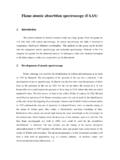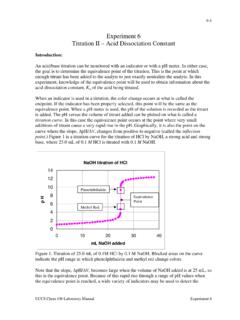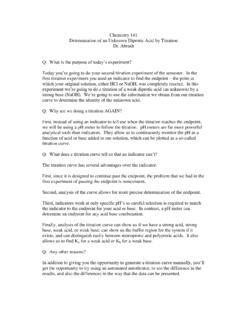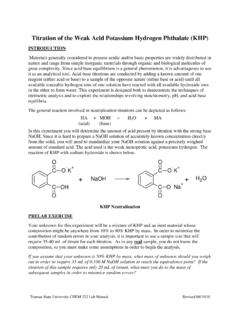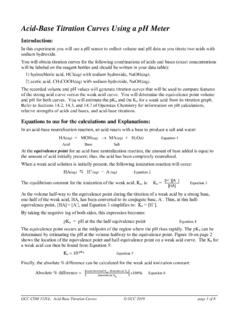Transcription of Solutions for the problems about „Calculation of pH in the ...
1 < strong >Solutionsstrong > for the < strong >problemsstrong > < strong >aboutstrong > Calculation of pH in the case of monoprotic acids and bases 1. What is the pH of a M acetic < strong >acidstrong > solution? Acetic < strong >acidstrong > is a weak < strong >acidstrong > with Ka = 10 5 and in this case cweak < strong >acidstrong > >>> Ka, that is the equation to use is: [H+] =acidweak ac K= ) (5 = M pH = -log[H+] = -log( ) = 2. What is the pH of a M ammonia solution? Ammonia is a weak < strong >basestrong > with Kb = 10 5 and in this case cweak < strong >basestrong > >>> Kb, that is the equation to use is: [OH ] =baseweak bc K= ) (5 = M pOH = -log[OH-] = -log( ) = pH = pH = = 3. What is the pH of a M sodium acetate solution?
2 Sodium acetate is a weak < strong >basestrong > , a conjugate < strong >basestrong > of acetic < strong >acidstrong > , so: acetatebacidaceticaKK = KW that is acidaceticaWacetatebKKK == = 10-10In this case cweak < strong >basestrong > >>> Kb, that is the equation to use is: [OH ] =baseweak bc K= ) (10 = 10-6 M pOH = -log[OH-] = -log( 10-6) = pH = pH = = 4. What is the concentration (in g/dm3 units) of an ammonia solution which has a pH of Ammonia is a weak < strong >basestrong > with Kb = 10 5. pH = that is pOH = pH = [OH-] = 10 pOH = 10 = 10-3 M ][OH][OHc][OHbaseweak b =K 33baseweak = 10-6 = 10-5 (cweak < strong >basestrong > 10-3) 10-6 = 10-5 cweak < strong >basestrong > 10-6 = 10-5 cweak < strong >basestrong > cweak < strong >basestrong > = M So, we have mol ammonia in 1 L solution, that is g ammonia (m = n = mol 17 g/mol) in 1 L solution.
3 The concentration is g/L. 5. A monobasic organic < strong >acidstrong > has a pK of The pH of a saturated solution of this < strong >acidstrong > is Calculate the solubility of this organic < strong >acidstrong > in mol/dm3 units. 1pH = , so [H+] = 10 pH = 10 = 10-4 M pK = , so Ka = 10 pK = 10 = 10-5 ][H][Hc][Hacidweak a+++ =K = < strong >acidstrong > weakc 10-8 = 10-5 (cweak < strong >acidstrong > 10-4) 10-8 = 10-5 cweak < strong >acidstrong > 10-8 = 10-5 cweak acidcweak < strong >acidstrong > = M 6. What is the pH and the degree of dissociation in a a) M; in a b) M and in a c) M acetic < strong >acidstrong > solution, respectively? a) Acetic < strong >acidstrong > is a weak < strong >acidstrong > , so: ][H][Hc][Hacidweak a+++ =K However, if the cweak < strong >acidstrong > = M, we can use the simpler form of the formula: < strong >acidstrong > weaka2c][H =+K [H+] = [H+] = 10-3 M pH = -log[H+] = -log( 10-3) = 2In this case [H+] = [acetate ion], so =acidweak c][H+= = % b)Acetic < strong >acidstrong > is a weak < strong >acidstrong > , so.
4 ][H][Hc][Hacidweak a+++ =K )][Hc(][Hacidweak a2++ =K 0)c(-])[H(][Hacidweak aa2= +++KK By solving the equation, 2)K4KK2aacid weakaac(-][H + =+= 10-4 M pH = -log[H+] = -log( 10-4) = In this case [H+] = [acetate ion], so =acidweak c][H+= = % c) Here again we do not have enough difference in the order of magnitude to ][H][Hc][Hacidweak a+++ =K )][Hc(][Hacidweak a2++ =K 0)c(-])[H(][Hacidweak aa2= +++KK By solving the equation, 2)K4KK2aacid weakaac(-][H + =+= 10-4 M pH = -log[H+] = -log( 10-4) = In this case [H+] = [acetate ion], so =acidweak c][H+= = % 7. What is the pH in a M solution of a moderately weak < strong >acidstrong > if the Ka = 10 1 ?
5 In the case of this moderately weak < strong >acidstrong > we do not have enough difference in the order of magnitude as = = . So the following formula should be used: ][H][Hc][Hacidweak a+++ =K )][Hc(][Hacidweak a2++ =K0)c(-])[H(][Hacidweak aa2= +++KK 0) (-])[ (][H112= + + + By solving the equation, 2)K4KK2aacid weakaac(-][H + =+= 10 3 M pH = -log[H+] = -log( 10 3) = 8. A windscreen washing liquid contains ammonia in g/dm3 concentration. What is the pH of this liquid? 1 L solution contains g of NH3, that is mol of NH3 (n = 17g 2= mol). So the concentration of ammonia is: cammonia = L 1mol M In this case, cweak < strong >basestrong > >>> Kb, so [OH ] =baseweak bc K= = M pOH = -log[OH ] = -log( ) = , pH = pOH = 9.
6 Cm3 of M ammonia solution is titrated with M HClO4. What is the added volume of titrant and the pH at 75% degree of titration? (6 cm3, ) The molar amount of ammonia: n = c V = M L = mol At 100 % titration, nHClO4 = nNH3 = mol At 75 % titration, nHClO4 = nNH3 = mol HClO4. We know the concentration ( M) of the HClO4 solution, so, the volume can be calculated: V = cn= L = 6 mL At 75 % titration, we have a buffer, NH3 and NH4Cl together. 75 % of the original NH3 amount is converted to NH4Cl, and 25 % is remained as NH3. So, using the equation for buffers: [OH-] = Kbsaltbaseweak nn = = = 10-6 M 3pOH = -log[OH ] = -log( 10-6) = , pH = pOH = 10.
7 The concentration of a monochloro acetic < strong >acidstrong > solution is M. What are the pH and the degree of dissociation in this solution? Ka = 10-3 Monochloro acetic < strong >acidstrong > is a weak < strong >acidstrong > and we do not have enough difference in the order of magnitude so the following formula should be used: ][H][Hc][Hacidweak a+++ =K The cweak < strong >acidstrong > = M and Ka = 10-3][H][ ][H3++ + = 0) (-])[ (][H332= + + + By solving the equation, 2) ( ) ( ][H-323-3 + = + [H+] = 10 4 M pH = log[H+] = log ( 10 4) pH = In this case [H+] = [monochloro acetate ion], so =acidweak c][H+= = % 11.
8 Calculate the pH when we add: a) 0 mL b) 9 mL c) 20 mL d) 25 mL NaOH solution whose concentration is M to a 10 mL sample of acetic < strong >acidstrong > . The concentration of the acetic < strong >acidstrong > is unknown (Ka= 10 5). First, calculate the concentration of the acetic < strong >acidstrong > if we know that 20 mL of NaOH is consumed up to the equivalence point. What kind of indicator would you use for this titration? Results: a) c(acetic < strong >acidstrong > ) = mol/dm3 b) at the beginning of the titration: 0 ml of < strong >basestrong > was added (weak < strong >acidstrong > ) pH = c) After the addition: 9 ml of < strong >basestrong > (buffer system) pH = d) After the addition: 20 ml of < strong >basestrong > (weak < strong >basestrong > ) pH = e) After the addition: 25 ml of < strong >basestrong > (excess of strong < strong >basestrong > ) pH = 412.
9 10 mL of acetic < strong >acidstrong > , whose concentration is unknown is titrated with potassium hidroxide. a) Calculate the concentration of the acetic < strong >acidstrong > if the volume of potassium hidroxide that is consumed up to the equivalence point is 16 mL. The concentration of KOH is M. b) Calculate the pH after the addition of 10 mL of KOH. Results: a) c(acetic < strong >acidstrong > ) = M b) It will be a buffer system: pH = 13. A 10 mL sample of acetic < strong >acidstrong > with M concentration is titrated with sodium hidroxide. The concentration of sodium hidroxide is M as well. Decide whether it is right or wrong to use an indicator whose pK= Support your opinion with calculations!
10 A) At first, we assume that the indicator marked the equivalence point correctly. This would mean that the same amounts of acetic < strong >acidstrong > and sodium hidroxide are present in the solution. n(acetic < strong >acidstrong > ) = 10 = 1 mmol n(acetic < strong >acidstrong > ) = n(NaOH) = 1 mmol This amount of NaOH is present in 10 mL of solution. Then you should calculate the pH of this solution (which contains a weak < strong >basestrong > , sodium acetate) to check your assumption < strong >aboutstrong > the indicator. Ka = 10 5 csalt/weak < strong >basestrong > = 201= M Kb= awKK= = 10 10 [OH ] =baseweak bc K= 10 6 M pOH = -log[OH ] = -log( 10 6) = pH = = From this result you can see that at the equivalent point the pH is , so the indicator was wrong.
